Overview
The article titled "10 Key Insights from Floating Solar Farm Assessments" presents critical findings and implications of floating solar technology in renewable energy. It asserts that floating photovoltaic systems deliver substantial advantages, such as efficient land use and enhanced energy production due to cooling effects from water. Furthermore, these systems offer significant environmental benefits, establishing them as a crucial solution for sustainable energy in the face of escalating global demand for renewable resources.
Introduction
Floating solar farms are rapidly emerging as a transformative solution in the quest for sustainable energy, harnessing the vast untapped potential of water bodies. With the escalating demand for renewable energy solutions, these innovative systems promise not only to alleviate land scarcity but also to enhance energy efficiency through advanced technologies. However, this opportunity is accompanied by a series of complex challenges, ranging from regulatory hurdles to environmental impacts.
What key insights can guide stakeholders in navigating this burgeoning field of floating photovoltaic systems?
Harbinger Land | Comprehensive Solutions for Land Services in Floating Solar Projects
Harbinger Land stands out as a leader in delivering tailored land services crucial for thriving energy initiatives, encompassing site and right-of-way acquisition, title research, and GIS mapping. Their extensive expertise ensures compliance with local regulations, facilitating seamless project execution while minimizing delays and enhancing client satisfaction. By leveraging cutting-edge technology, including AI-powered title research software and highly integrated GIS modeling services, Harbinger Land significantly elevates the accuracy and efficiency of land acquisition processes. This positions them as an indispensable ally for developers navigating the complexities of the dynamic renewable sector, particularly as the demand for sustainable solutions continues to escalate.
Recent statistics indicate that the buoyant photovoltaic market is projected to grow at a CAGR of 27.47% from 2025 to 2034, underscoring the urgent need for efficient land services in this rapidly expanding sector. Moreover, successful site acquisition presents a critical challenge, with many developers encountering obstacles related to regulatory compliance and environmental assessments, including the navigation of complex permitting processes. Harbinger Land's commitment to innovation, featuring efficient document imaging solutions that enhance the speed and cost-effectiveness of title research and leasing, ensures that they remain at the forefront of addressing these challenges, solidifying their role as a key player in the evolving landscape of renewable energy.
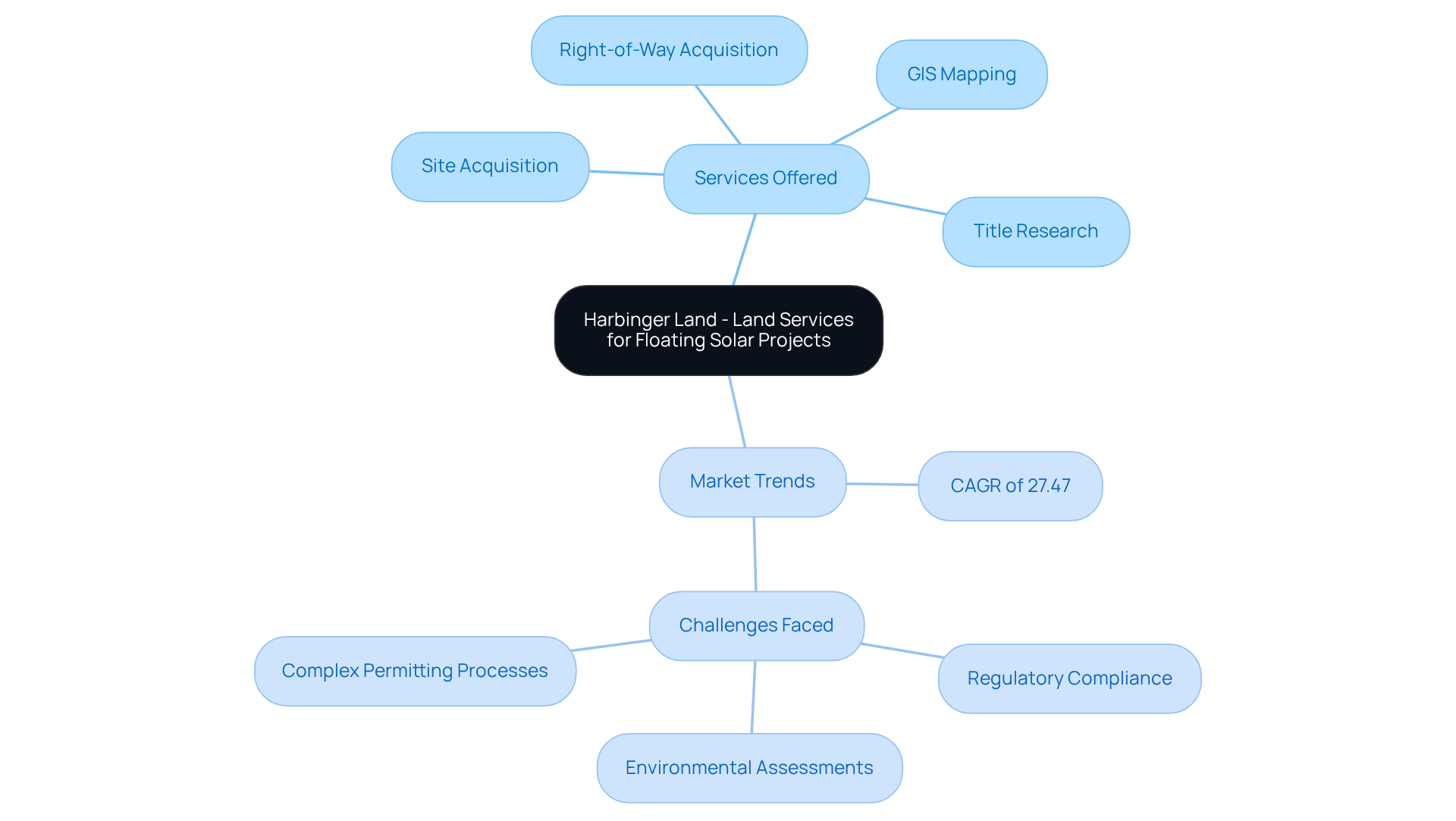
Floating Photovoltaic Systems: Harnessing Technology for Sustainable Energy
Floating solar farm assessments indicate that floating photovoltaic (FPV) systems represent a groundbreaking approach to harnessing sunlight, utilizing advanced panel technology mounted on floating platforms. This innovative design captures resources without consuming valuable land space, making it particularly advantageous in areas facing land scarcity. By functioning effectively in diverse water environments, FPV systems leverage the natural cooling effect of water, significantly enhancing panel performance.
Recent advancements, such as the implementation of bifacial panels that capture sunlight from both sides, have further maximized power output. These developments position FPV systems as a crucial component in floating solar farm assessments for the transition toward sustainable energy. The buoyant photovoltaic market is projected to expand considerably, reaching an estimated $10.63 billion by 2029, driven by the increasing demand for renewable energy solutions.
As the world grapples with the complexities of land acquisition, including legal and regulatory hurdles, FPV systems offer a viable solution that addresses these challenges while promoting environmental sustainability.
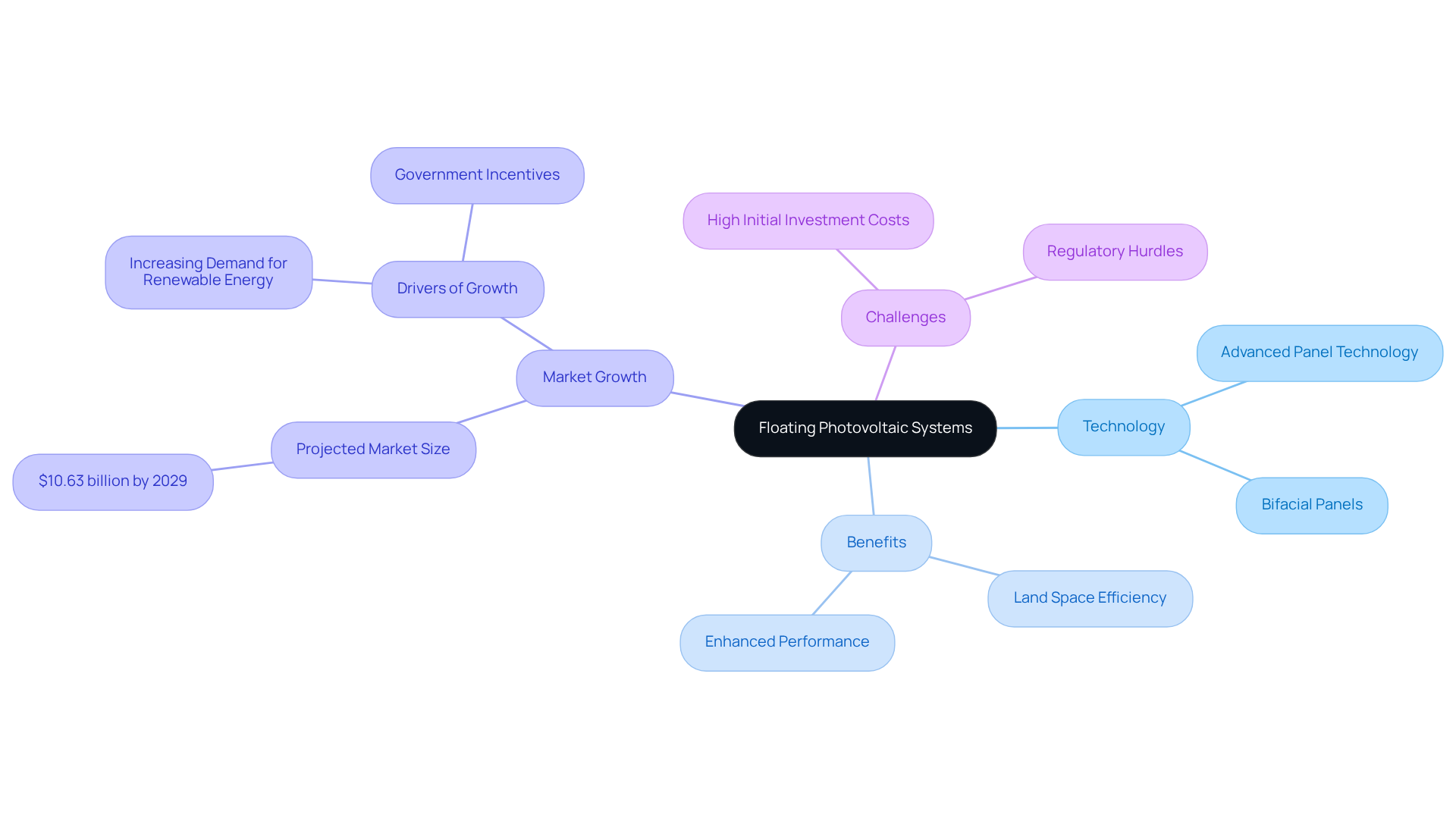
Risk Assessment Strategies for Successful Floating Solar Farm Implementation
Effective risk evaluation methods for floating solar farm assessments are essential for recognizing potential dangers, including severe weather situations, water quality problems, and structural stability issues. The buoyant photovoltaic technology is anticipated to expand at a compound annual growth rate of 15% over the coming decade, highlighting the importance of floating solar farm assessments and strong risk management. Techniques like SWOT analysis enable managers to systematically assess strengths, weaknesses, opportunities, and threats related to floating solar farm assessments. Additionally, floating solar farm assessments offer insights into the political, economic, social, technological, legal, and environmental factors that influence the feasibility of these initiatives.
The upcoming 2025 hurricane season, predicted to have above-average activity, highlights the necessity for preparedness against extreme weather risks. Consistent oversight and flexible management strategies are crucial to address new risks throughout the lifecycle of floating solar farm assessments, ensuring the long-term success and sustainability of solar installations on water. For instance, a study on the implications of floating solar farm assessments on hydropower in New Zealand illustrates how effective risk assessment strategies can enhance project outcomes. By proactively managing these risks, stakeholders can bolster the resilience and bankability of their renewable energy investments, particularly through floating solar farm assessments.
As Daniel Schroeder from Allianz Commercial observes, 'With the climate crisis escalating a sense of urgency, photovoltaic energy will be a guiding force in the transformation of the power sector.' This statement emphasizes the essential function of efficient risk management in developing land acquisition strategies for floating solar farm assessments within buoyant energy initiatives.
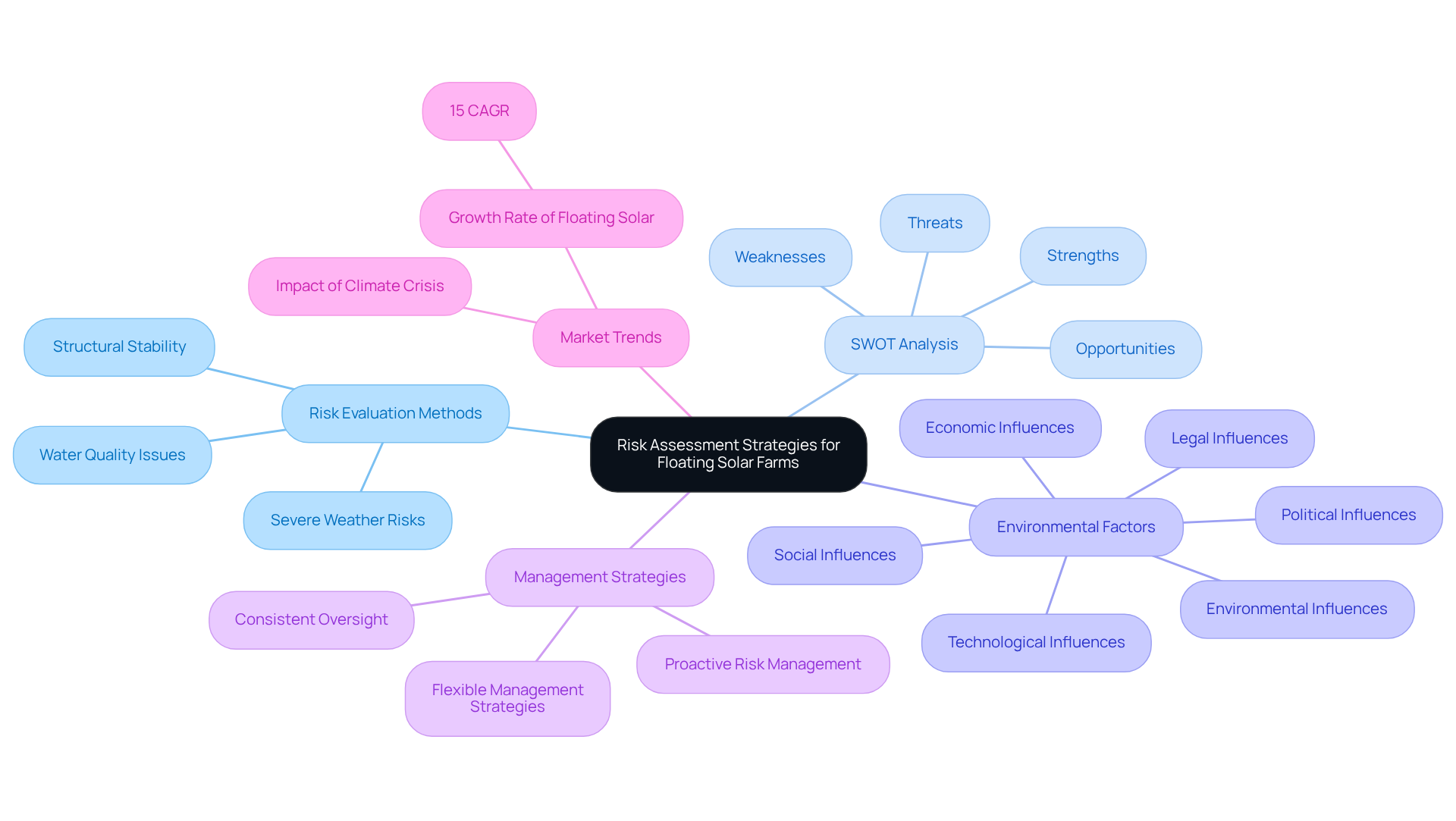
Economic Viability of Floating Solar Farms: Key Financial Insights
The financial feasibility of buoyant photovoltaic installations is underpinned by several critical factors. Notably, there has been a substantial decrease in land procurement expenses, alongside the capability to generate power in regions with limited land availability. Financial evaluations reveal that buoyant photovoltaic projects can achieve a competitive levelized cost of power (LCOE) relative to traditional installations. For instance, the LCOE for these systems is often reduced due to the cooling effects of water, which enhance conversion efficiency, as well as the absence of land-related costs.
Furthermore, governmental incentives and a growing demand for renewable energy solutions significantly bolster the financial appeal of buoyant photovoltaic farms, positioning them as an attractive investment opportunity. Expert insights suggest that as technology evolves and operational efficiencies improve, the economic landscape for buoyant renewable energy systems will continue to strengthen, making these initiatives increasingly appealing to stakeholders looking to capitalize on sustainable energy solutions.
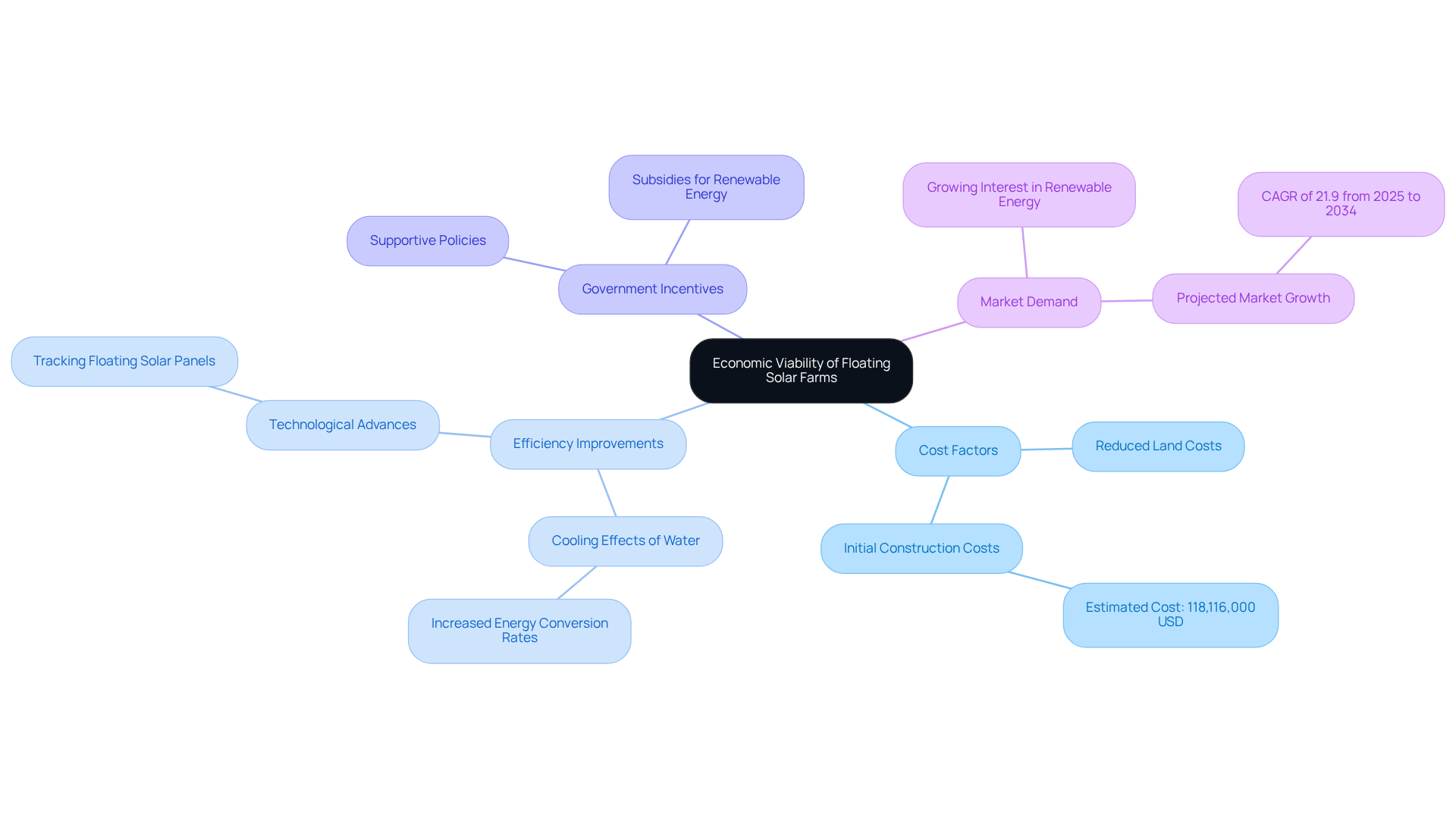
Environmental Benefits of Floating Solar Farms: A Sustainable Solution
Floating solar farm assessments indicate that floating photovoltaic farms present substantial environmental advantages, particularly in reducing water evaporation and enhancing water quality. By covering extensive water bodies, these systems limit sunlight penetration, effectively managing algae growth and safeguarding aquatic ecosystems. Buoyant photovoltaic systems, for instance, can create habitats that nurture biodiversity, thereby fostering a healthier marine environment.
Studies reveal that these installations can drastically lower evaporation rates, with projections indicating a potential reduction of up to 106 cubic kilometers annually in the U.S. alone, as underscored in a recent global study. The dual benefit of energy generation and water preservation aligns seamlessly with global sustainability goals, which is why floating solar farm assessments position buoyant photovoltaic farms as a compelling solution within the renewable resources sector.
As countries like India and Japan expand their buoyant photovoltaic capacities, the advantageous environmental impacts are increasingly evident, showcasing the potential of these technologies to significantly contribute to ecological preservation and efficiency.
Environmental expert Dr. Jane Smith asserts, "Floating photovoltaic farms not only produce clean energy but also play a crucial role in preserving water quality and supporting aquatic life, making them an essential component of sustainable energy solutions.
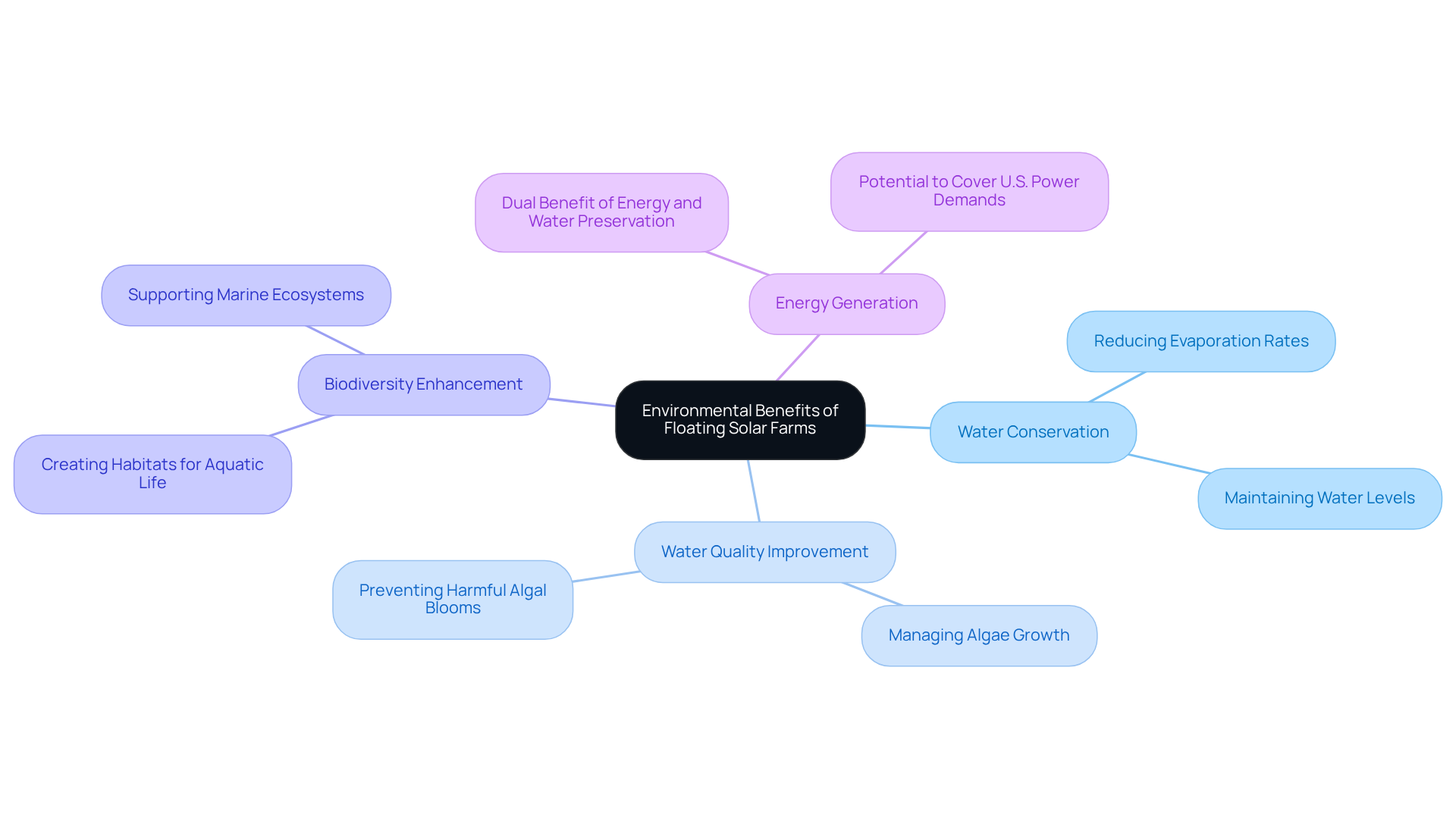
Cross-Disciplinary Collaboration: Essential for Floating Solar Success
Successful buoyant energy initiatives hinge on the efficient cooperation among engineers, environmental scientists, regulatory specialists, and community stakeholders. This cross-disciplinary approach not only addresses technical feasibility and environmental impact assessments but also incorporates floating solar farm assessments to cultivate innovative solutions to complex challenges. By involving a diverse range of specialists, acceptance within local communities is significantly enhanced, greatly aiding the overall success of floating solar initiatives.
Statistics reveal that initiatives with strong stakeholder engagement achieve a remarkable completion rate of 85%, in contrast to just 65% for those with minimal involvement. Furthermore, floating solar farm assessments that prioritize cross-disciplinary collaboration are 30% more likely to introduce successful innovations, underscoring the critical importance of teamwork in renewable energy development.
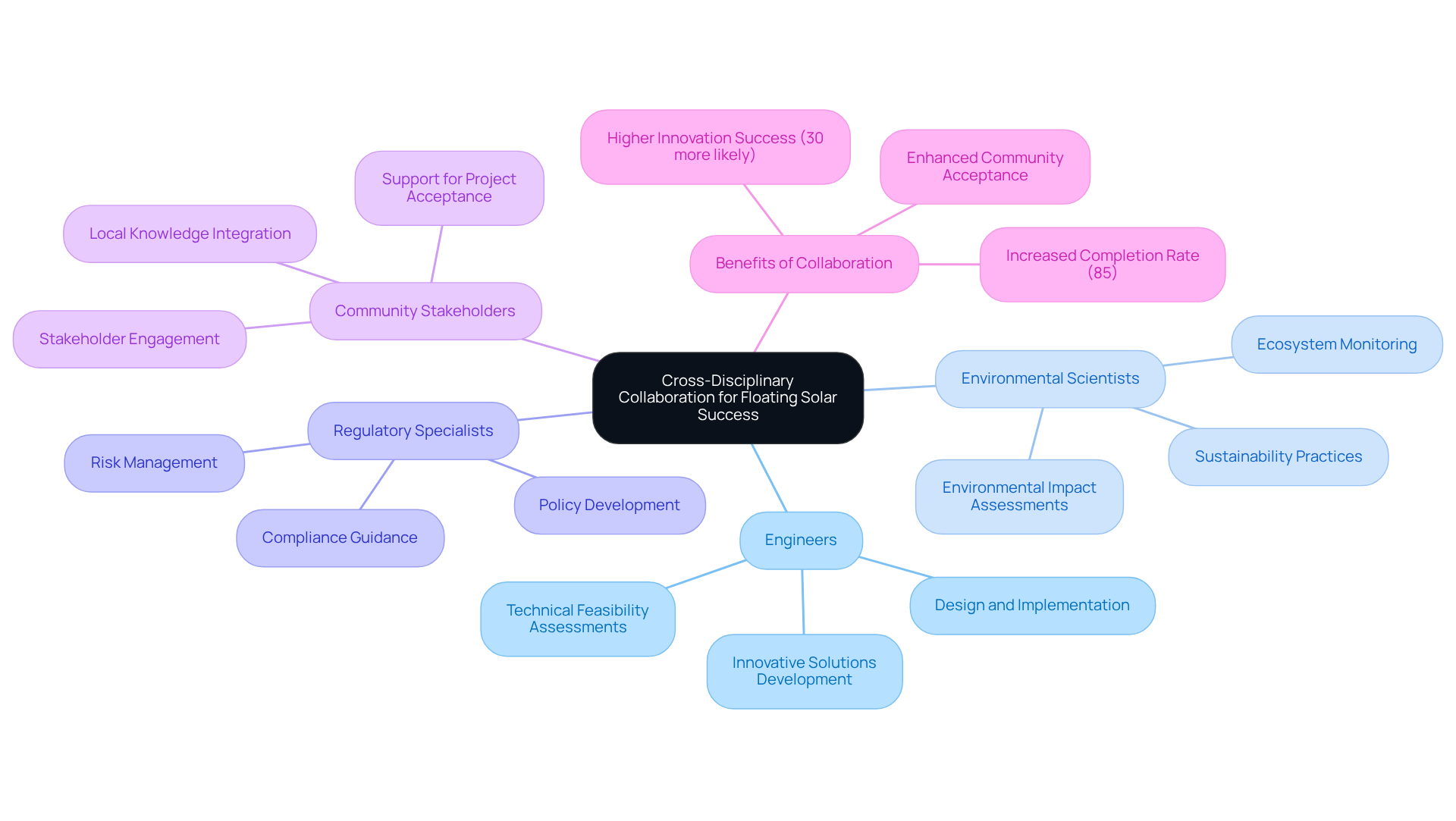
Geographical Considerations for Optimal Floating Solar Farm Locations
A meticulous examination of various geographical factors, including water depth, proximity to existing infrastructure, and regional climate conditions, is required for floating solar farm assessments to choose optimal sites. The most suitable locations are typically calm bodies of water, such as reservoirs, lakes, and ponds, where the installation of photovoltaic panels can occur with minimal wave action. Geographic Information Systems (GIS) technology is essential in floating solar farm assessments, enabling comprehensive evaluations of potential sites to ensure they are characterized by high sunlight exposure and minimal environmental disturbance.
A systematic review of buoyant photovoltaic siting studies, particularly focusing on floating solar farm assessments, has revealed trends and gaps in site selection criteria, underscoring the significance of integrating GIS analysis into the site selection process. This approach not only enhances the effectiveness of buoyant energy initiatives but also aids in identifying sites that optimize energy collection while minimizing ecological impacts. Research indicates that buoyant photovoltaic systems could potentially generate nearly 10% of current U.S. electricity needs by utilizing 27% of suitable water bodies.
Moreover, floating photovoltaic projects stand to benefit significantly from being situated in areas with stable water levels and favorable weather conditions, which are vital for improving performance and reliability. However, it is crucial to consider potential ecological impacts, such as hypoxic conditions and reduced biomass accumulation of submerged plants, to maintain a balanced perspective on the environmental considerations involved in site selection. Local climate conditions, including wind speed and sunlight exposure, are critical factors that must be tailored to specific geographical contexts.
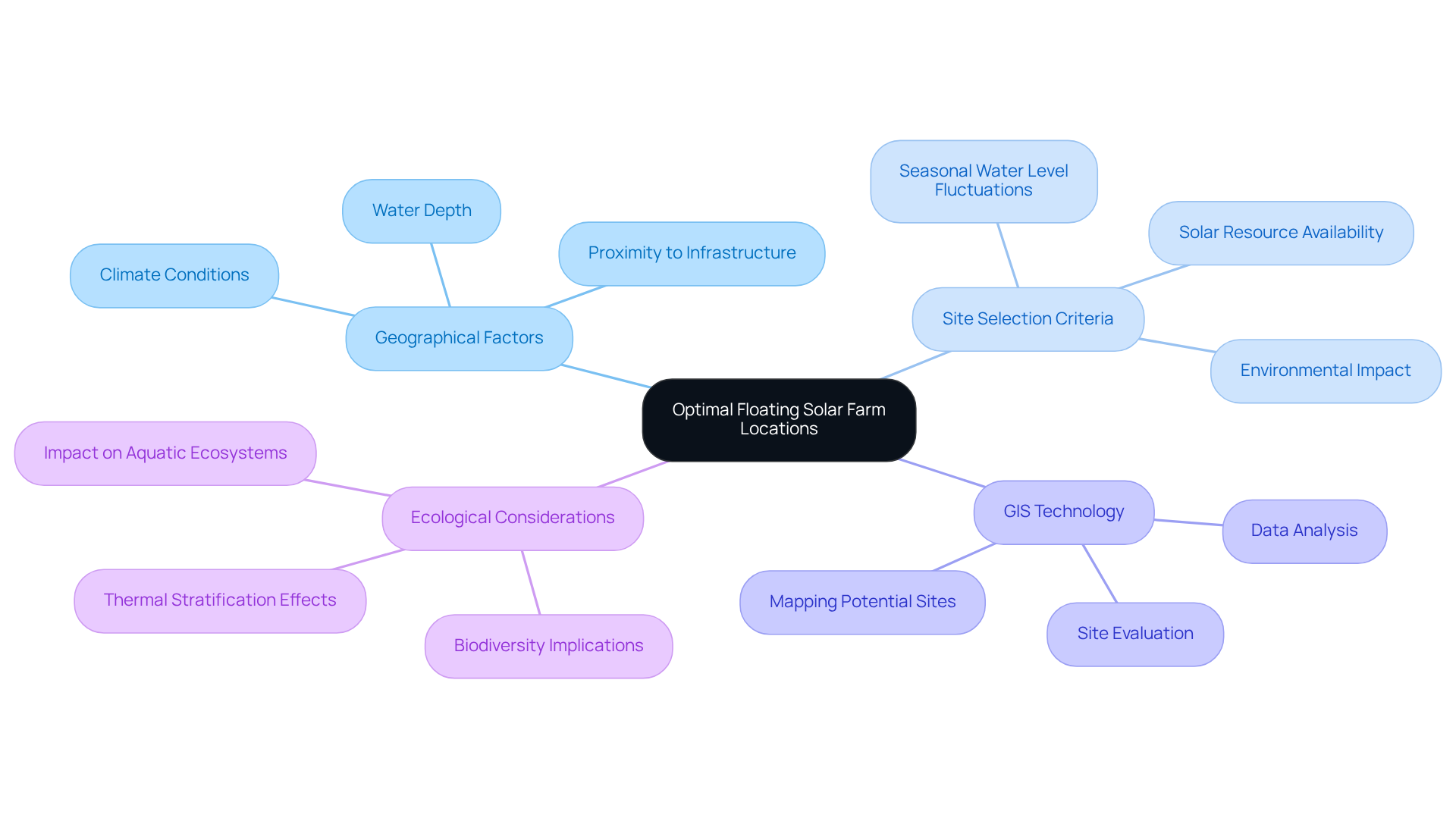
Navigating Regulatory Challenges in Floating Solar Farm Development
Floating solar farm assessments frequently encounter regulatory challenges, particularly in permitting processes, environmental impact assessments, and local zoning laws. Developers must engage with regulatory agencies early in the project planning phase to navigate these complexities effectively. This proactive approach is essential for securing necessary approvals and avoiding costly delays. Understanding the regulations governing water bodies and power generation is vital; non-compliance can lead to significant setbacks and increased costs.
Harbinger Land's expertise in site and right-of-way acquisitions, coupled with highly integrated GIS modeling services, streamlines the acquisition of leases and easements for distributed energy resources (DER) and infrastructure development. By employing GIS mapping and expert title research services, developers can save time and reduce costs, enabling informed decisions that enhance efficiency in land rights acquisition.
Successful permitting processes often involve thorough environmental assessments, such as floating solar farm assessments, and community engagement to address potential concerns. Legal specialists emphasize that adherence to local regulations not only facilitates smoother development of initiatives but also fosters community support—an essential factor for the long-term success of renewable energy projects.
By prioritizing these elements and leveraging Harbinger Land's capabilities, developers can significantly improve their chances of achieving timely and efficient implementation. To enhance your success, consider reaching out to Harbinger Land to explore how our services can assist your buoyant energy projects.
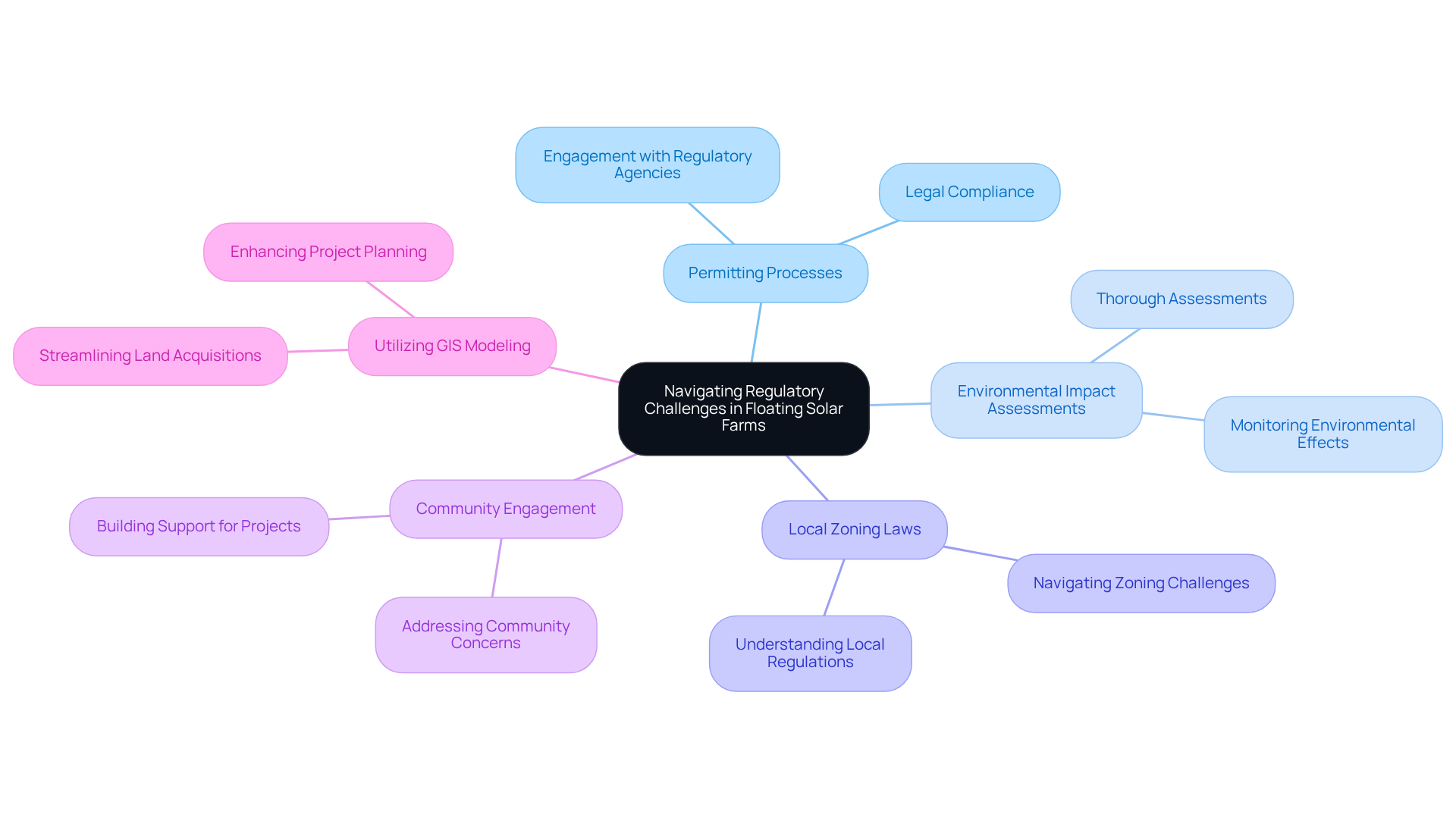
Impact of Water Conditions on Floating Solar Farm Performance
Floating solar farm assessments are influenced by water conditions, including temperature, wave action, and water quality, which are critical factors for their performance. Cooler water temperatures can significantly enhance solar panel efficiency, with panels operating optimally at ambient temperatures around 25°C. Notably, a 1°C increase in temperature can decrease efficiency by as much as 0.5%. This emphasizes the importance of maintaining cooler conditions for optimal power generation.
Excessive wave action presents structural challenges that can lead to potential energy losses. Research indicates that buoyant energy units may experience an average power reduction of 12.7% due to pitch movements triggered by waves, particularly at a pitch amplitude of 6.7°. This highlights the necessity for robust design approaches to mitigate these impacts. Furthermore, regular monitoring of water conditions, including parameters such as dissolved oxygen levels and nutrient concentrations, is essential for ensuring optimal performance and implementing necessary adjustments to buoyant energy systems.
Case studies have demonstrated that the arrangement of buoyant panels can lead to significant alterations in water temperature profiles, with increases of up to 0.32°C observed beneath the panels. This thermal effect can influence the stratification and stability of the water column, thereby impacting nutrient distribution and overall water quality. Understanding these dynamics is crucial for developing better design and operational strategies, particularly in floating solar farm assessments, that maximize energy output while ensuring environmental sustainability.
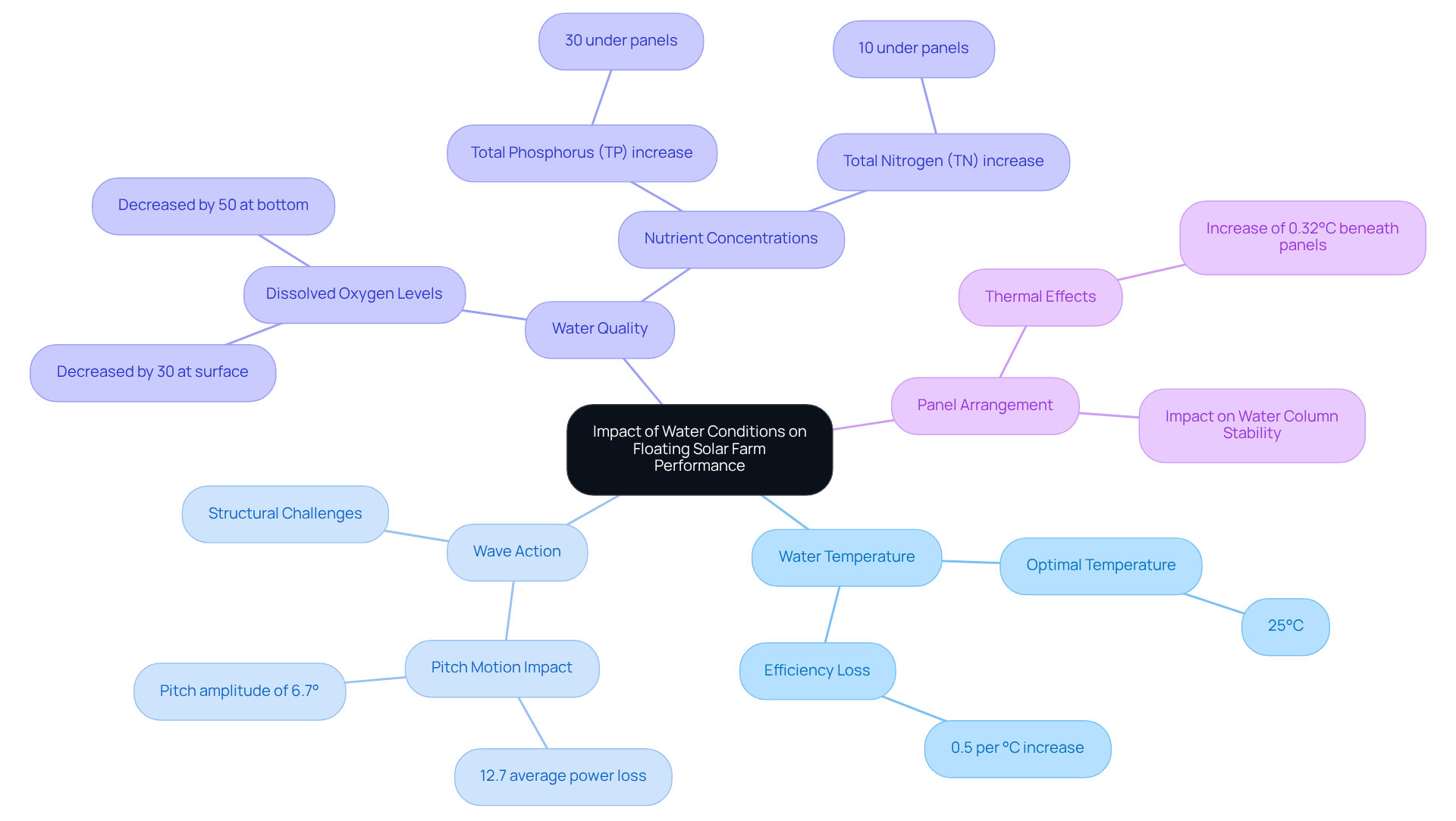
Future Outlook for Floating Solar Technology: Trends and Predictions
The future of buoyant photovoltaic technology is exceptionally bright, driven by significant advancements in materials, design, and efficiency. Innovations such as enhanced anchoring systems and advanced photovoltaic panel technologies are poised to improve the viability of buoyant energy farms across diverse settings. As global demand for sustainable power rises, floating solar farm assessments are increasingly recognizing buoyant photovoltaic systems as a vital solution, particularly in regions where land is scarce. This technology not only conserves valuable land resources but also aligns with sustainability goals, positioning it as a key player in the transition to cleaner energy sources.
The buoyant photovoltaic panel market is projected to expand from $3.94 billion in 2024 to $4.82 billion in 2025, reflecting a compound annual growth rate (CAGR) of 22.2%. Notably, the Cirata buoyant photovoltaic facility in Indonesia, inaugurated in November 2023, aims to supply energy to 50,000 households while reducing 214,000 metric tons of CO2 emissions annually. This underscores the tangible impact of buoyant photovoltaic technology.
Industry leaders like Trina Solar assert that government incentives and technological innovations will further propel the adoption of floating solar farm assessments, thereby reinforcing their role in addressing global energy needs. Are you ready to explore how this transformative technology can benefit your energy strategy?
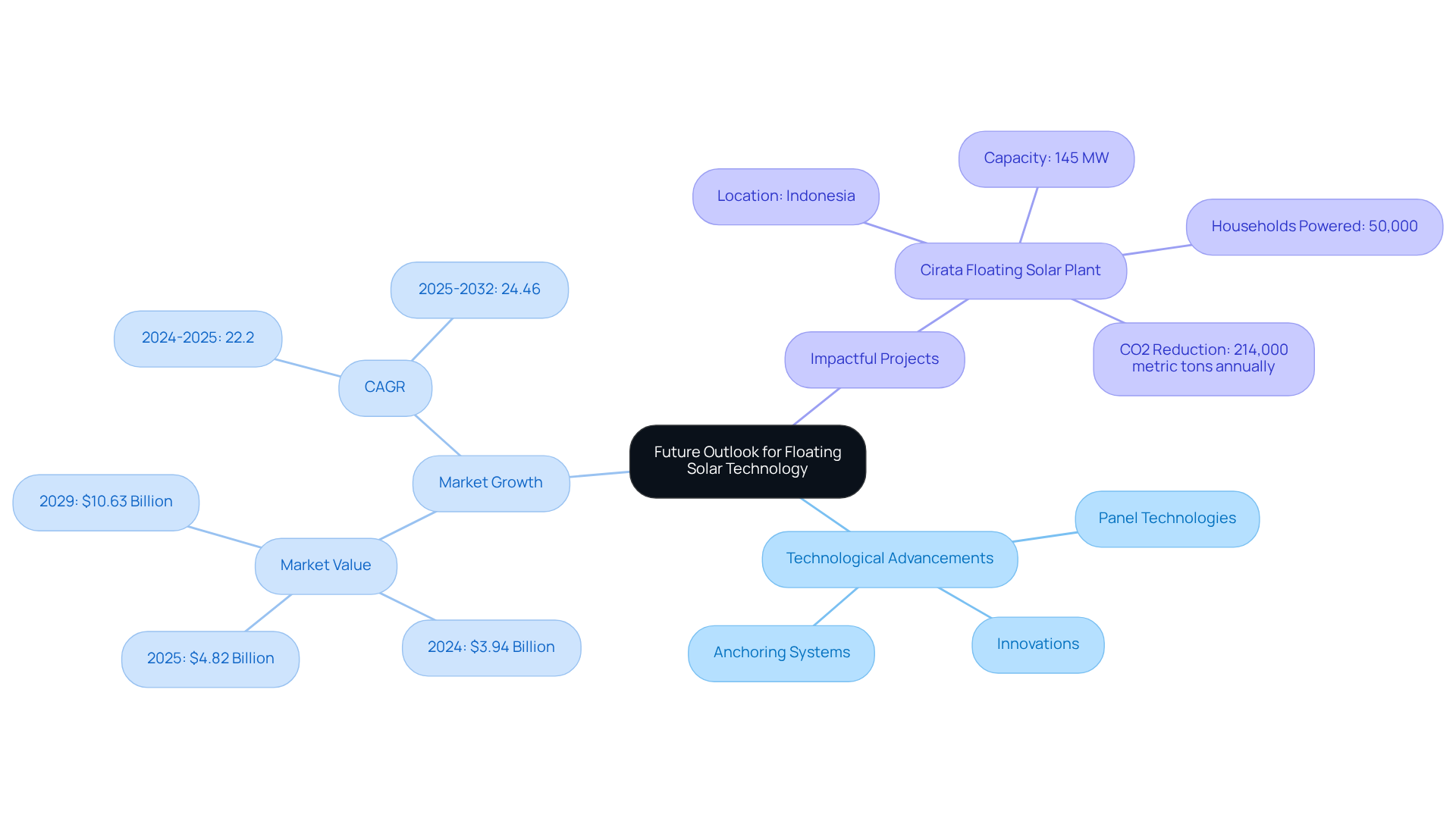
Conclusion
Floating solar farms are emerging as a pivotal solution in the quest for sustainable energy, effectively addressing land scarcity while maximizing energy production. This innovative approach harnesses the benefits of advanced photovoltaic technology mounted on floating platforms, allowing for efficient energy generation without the drawbacks of traditional land-based installations.
Key insights reveal the multifaceted advantages of floating solar systems:
- Enhanced performance due to the cooling effects of water
- Significant environmental benefits such as reduced water evaporation
- Improved aquatic ecosystems
These factors showcase the vast potential of buoyant photovoltaic technology. Moreover, the importance of cross-disciplinary collaboration and effective risk management strategies is essential for successful project implementation. The economic viability of these systems underscores their competitive edge in the renewable energy market.
As the demand for sustainable solutions continues to rise, embracing floating solar technology aligns with global energy needs and contributes to ecological preservation. Stakeholders are encouraged to reflect on how these innovative systems can be integrated into their energy strategies, ensuring a cleaner, more sustainable future for all. The advancements in floating solar technology represent not just a trend, but a significant step towards achieving energy resilience and environmental sustainability.
Frequently Asked Questions
What services does Harbinger Land provide for floating solar projects?
Harbinger Land offers tailored land services including site and right-of-way acquisition, title research, and GIS mapping, ensuring compliance with local regulations and facilitating seamless project execution.
How does Harbinger Land enhance the efficiency of land acquisition processes?
They leverage cutting-edge technology such as AI-powered title research software and integrated GIS modeling services to significantly elevate the accuracy and efficiency of land acquisition.
What is the projected growth of the buoyant photovoltaic market?
The buoyant photovoltaic market is projected to grow at a compound annual growth rate (CAGR) of 27.47% from 2025 to 2034, reaching an estimated $10.63 billion by 2029.
What are floating photovoltaic (FPV) systems?
FPV systems are innovative solar solutions that utilize advanced panel technology mounted on floating platforms, capturing sunlight without consuming valuable land space and enhancing performance through the natural cooling effect of water.
What advancements have been made in FPV systems?
Recent advancements include the implementation of bifacial panels that capture sunlight from both sides, maximizing power output.
What are the key risks associated with floating solar farm assessments?
Key risks include severe weather situations, water quality problems, and structural stability issues.
How can risk assessment strategies benefit floating solar farm projects?
Effective risk assessment strategies, such as SWOT analysis, help recognize potential dangers and improve project outcomes by systematically evaluating strengths, weaknesses, opportunities, and threats.
Why is risk management important for floating solar farm assessments?
Risk management is crucial for ensuring the long-term success and sustainability of solar installations on water, especially in light of challenges such as extreme weather events and regulatory compliance.
How can stakeholders improve the resilience of their renewable energy investments?
By proactively managing risks through consistent oversight and flexible management strategies, stakeholders can enhance the resilience and bankability of their floating solar farm projects.
List of Sources
- Harbinger Land | Comprehensive Solutions for Land Services in Floating Solar Projects
- Quotes About Solar Power: 50 Picks to Light Up Your Life - Lumify Energy (https://lumifyenergy.com/blog/quotes-about-solar-power)
- Floating Solar Market Size to Hit USD 75.76 Billion by 2034 (https://precedenceresearch.com/floating-solar-market)
- Floating Solar Panels Market Size, Share, Trends, & Insights Report, 2035 (https://rootsanalysis.com/floating-solar-panels-market)
- Floating Solar Market Size, Share & Trends Report, 2024-2033 (https://novaoneadvisor.com/report/floating-solar-market)
- Global Floating Solar Panels Market Size & Share | Report 2031 (https://transparencymarketresearch.com/floating-solar-panels-market.html)
- Floating Photovoltaic Systems: Harnessing Technology for Sustainable Energy
- Quotes About Solar Power: 50 Picks to Light Up Your Life - Lumify Energy (https://lumifyenergy.com/blog/quotes-about-solar-power)
- Floating Solar Panel Market Analysis & Forecast Report 2025 (https://thebusinessresearchcompany.com/report/floating-solar-panel-global-market-report)
- Global Floating Solar Market Investment Landscape 2025-2032 (https://statsndata.org/report/floating-solar-market-6207)
- Floating Photovoltaic Power Station 2025 to Grow at XX CAGR with XXX million Market Size: Analysis and Forecasts 2033 (https://marketreportanalytics.com/reports/floating-photovoltaic-power-station-221160)
- Floating Solar System: Disruptive Technologies Driving Market Growth 2025-2033 (https://marketreportanalytics.com/reports/floating-solar-system-229545)
- Risk Assessment Strategies for Successful Floating Solar Farm Implementation
- Best practices in risk management for renewable energy projects | Marsh (https://marsh.com/en/industries/energy-and-power/insights/best-practices-in-risk-management-for-renewable-energy-projects.html)
- (PDF) Risk Assessment and Policy Recommendations for a Floating Solar Photovoltaic (FSPV) System (https://researchgate.net/publication/379150926_Risk_Assessment_and_Policy_Recommendations_for_a_Floating_Solar_Photovoltaic_FSPV_System)
- Emerging Risk: Solar Power | Allianz Commercial (https://commercial.allianz.com/news-and-insights/reports/emerging-risk-solar-power.html)
- Risk management in renewable energy projects (https://farrellymitchell.com/risk-advisory-services/risk-management-in-renewable-energy-projects)
- Economic Viability of Floating Solar Farms: Key Financial Insights
- Floating Solar Panel Market Analysis & Forecast Report 2025 (https://thebusinessresearchcompany.com/report/floating-solar-panel-global-market-report)
- Economic Feasibility and Strategic Planning for Floating Solar Power Plants in Korea: A Real Options Approach (https://mdpi.com/2071-1050/17/1/137)
- Solar Floating Panel Market Report | Global Forecast From 2025 To 2033 (https://dataintelo.com/report/global-solar-floating-panel-market)
- Global Floating Solar Market Investment Landscape 2025-2032 (https://statsndata.org/report/floating-solar-market-6207)
- Floating Solar System Market Demand and Growth Insights 2025 (https://usdanalytics.com/industry-reports/floating-solar-system-market)
- Environmental Benefits of Floating Solar Farms: A Sustainable Solution
- India's Floating Solar Farms Transform Reservoirs into Clean Energy Hubs | Impactful Ninja (https://impactful.ninja/indias-floating-solar-farms-transform-reservoirs)
- Japan's 180,000 m² Floating Solar Farm Revolutionizes Clean Energy | Impactful Ninja (https://impactful.ninja/japan-floating-solar-farm-clean-energy)
- Floating Solar Panels Patents - Insights and Stats (https://insights.greyb.com/floating-solar-panels-patents)
- Solar Energy Statistics and Facts 2024 (https://electroiq.com/stats/solar-energy-statistics)
- Harnessing the Sun: Floating Solar Farms (https://justenergy.com/blog/floating-solar-farms)
- Cross-Disciplinary Collaboration: Essential for Floating Solar Success
- (PDF) FOSTERING CROSS-DISCIPLINARY COLLABORATION IN OFFSHORE PROJECTS: STRATEGIES AND BEST PRACTICES (https://researchgate.net/publication/379693567_FOSTERING_CROSS-DISCIPLINARY_COLLABORATION_IN_OFFSHORE_PROJECTS_STRATEGIES_AND_BEST_PRACTICES)
- The Role of CrossDisciplinary Collaboration in Enhancing Innovation Management Training: Techniques That Work" (https://blogs.psico-smart.com/blog-the-role-of-crossdisciplinary-collaboration-in-enhancing-innovation-management-training-techniques-that-work-181836)
- (PDF) The importance of interdisciplinary collaboration for successful engineering project completions: A strategic framework (https://researchgate.net/publication/387730457_The_importance_of_interdisciplinary_collaboration_for_successful_engineering_project_completions_A_strategic_framework)
- What Statistics Indicate Community Involvement's Impact on Project Success? → Question (https://sustainability-directory.com/question/what-statistics-indicate-community-involvements-impact-on-project-success)
- Top Ten Quotes about Solar Power (https://harnessoursun.com/top-ten-quotes-about-solar-power)
- Geographical Considerations for Optimal Floating Solar Farm Locations
- Revolutionizing Floating Solar Farm Construction: Cutting-Edge Design and Installation Techniques (https://accusolar.com/floating-solar-farm/floating-solar-farm-construction)
- Siting Considerations for Floating Solar Photovoltaic Energy: A Systematic Review (https://papers.ssrn.com/sol3/papers.cfm?abstract_id=4866010)
- The impact of floating photovoltaic power plants on lake water temperature and stratification - Scientific Reports (https://nature.com/articles/s41598-023-34751-2)
- Floating solar photovoltaic plants in India – A rapid transition to a green energy market and sustainable future - J. Charles Rajesh Kumar, MA Majid, 2023 (https://journals.sagepub.com/doi/10.1177/0958305X211057185?icid=int.sj-full-text.similar-articles.5)
- Navigating Regulatory Challenges in Floating Solar Farm Development
- War of Words: Top Quotes From the Solar Industry’s Latest Salvo Over Trade (https://greentechmedia.com/articles/read/top-quotes-from-the-solar-industrys-latest-salvo-over-trade)
- Spain issues new regulations for floating solar PV plants on public reservoirs (https://pv-tech.org/spain-issues-new-regulations-for-floating-solar-pv-plants-on-public-reservoirs)
- The Executive Headlines - Top business magazine & news headlines sources (https://executiveheadlines.com/erp/quotes-on-sustainable-energy)
- Exploring the Challenges of Floating Solar Panel Systems (https://integratesun.com/post/exploring-the-challenges-of-floating-solar-panel-systems)
- Impact of Water Conditions on Floating Solar Farm Performance
- How Do Temperature and Shade Affect Solar Panel Efficiency? – | Boston Solar | MA (https://bostonsolar.us/solar-blog-resource-center/blog/how-do-temperature-and-shade-affect-solar-panel-efficiency)
- How Weather Conditions Affect Solar Panel Efficiency | Tenmen Electrical (https://tenmenelectrical.com/how-weather-conditions-affect-solar-panel-efficiency)
- Impacts of a floating photovoltaic system on temperature and water quality in a shallow tropical reservoir - Limnology (https://link.springer.com/article/10.1007/s10201-022-00698-y)
- Floating solar power loss due to motions induced by ocean waves: An experimental study (https://sciencedirect.com/science/article/pii/S0029801824023266)
- The environmental factors affecting solar photovoltaic output (https://sciencedirect.com/science/article/pii/S1364032124007998)
- Future Outlook for Floating Solar Technology: Trends and Predictions
- Floating Solar Panel Market Analysis & Forecast Report 2025 (https://thebusinessresearchcompany.com/report/floating-solar-panel-global-market-report)
- Stellar Market Research (https://stellarmr.com/report/floating-solar-panels-market/2608)
- Floating Solar System: Disruptive Technologies Driving Market Growth 2025-2033 (https://marketreportanalytics.com/reports/floating-solar-system-229545)
- Tracking Floating Solar Panels Market Report | Global Forecast From 2025 To 2033 (https://dataintelo.com/report/tracking-floating-solar-panels-market)
- Global Floating Solar Plants Market Scenario Forecasting 2025-2032 (https://statsndata.org/report/floating-solar-plants-market-17793)




